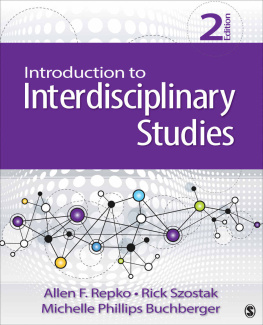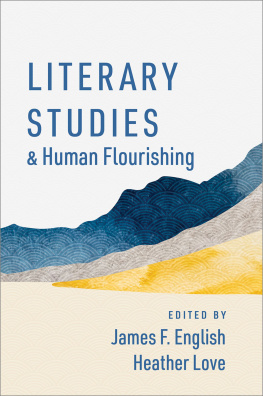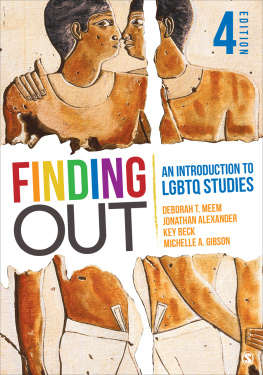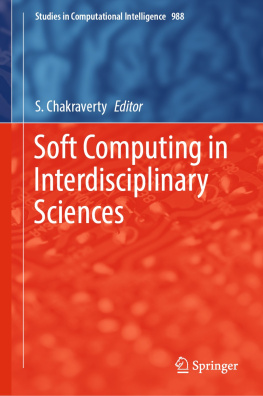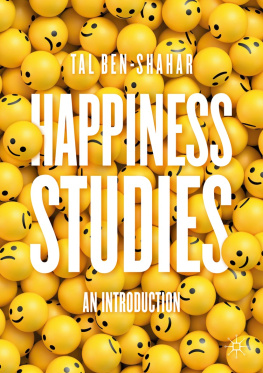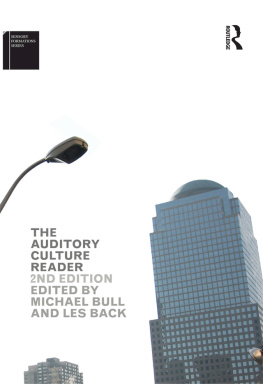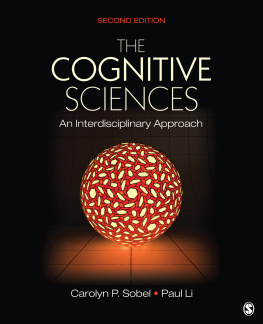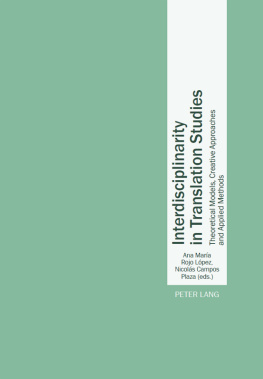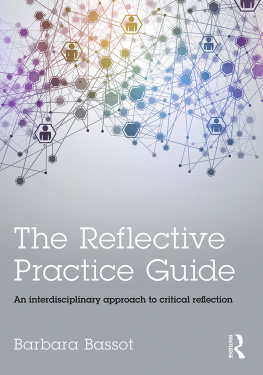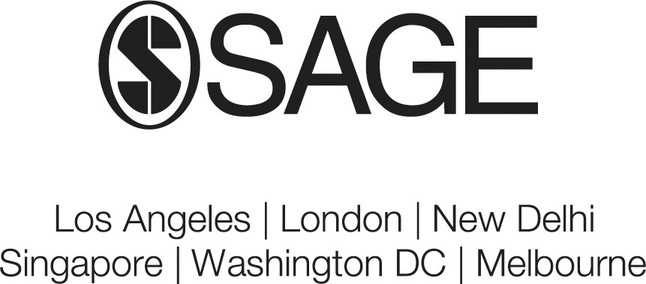Introduction to Interdisciplinary Studies
Second Edition
To my wife, children, and grandchildren
The greatest force in the world is an idea whose time has come.
Introduction to Interdisciplinary Studies
Second Edition
- Allen F. Repko
- University of Texas at Arlington (Retired)
- Rick Szostak
- University of Alberta, Edmonton, Canada
- Michelle Phillips Buchberger
- Miami University
FOR INFORMATION:
SAGE Publications, Inc.
2455 Teller Road
Thousand Oaks, California 91320
E-mail: order@sagepub.com
SAGE Publications Ltd.
1 Olivers Yard
55 City Road
London, EC1Y 1SP
United Kingdom
SAGE Publications India Pvt. Ltd.
B 1/I 1 Mohan Cooperative Industrial Area
Mathura Road, New Delhi 110 044
India
SAGE Publications Asia-Pacific Pte. Ltd.
3 Church Street
#1004 Samsung Hub
Singapore 049483
Copyright 2017 by SAGE Publications, Inc.
All rights reserved. No part of this book may be reproduced or utilized in any form or by any means, electronic or mechanical, including photocopying, recording, or by any information storage and retrieval system, without permission in writing from the publisher.
Printed in the United States of America
Library of Congress Cataloging-in-Publication Data
Names: Repko, Allen F. | Szostak, Rick, 1959- author. | Buchberger, Michelle Phillips, author.
Title: Introduction to interdisciplinary studies / Allen F. Repko, University of Texas at Arlington (retired), Rick Szostak, University of Alberta, Edmonton, Canada, Michelle Phillips Buchberger, Miami University.
Description: Second edition. | Los Angeles : Sage, [2017] | Includes bibliographical references and index.
Identifiers: LCCN 2016023303 | ISBN 9781506346892 (pbk. : alk. paper)
Subjects: LCSH: Interdisciplinary approach to knowledge. | Social sciences.
Classification: LCC Q180.55.I48 R473 2017 | DDC 300dc23 LC record available at https://lccn.loc.gov/2016023303
This book is printed on acid-free paper.
Acquisitions Editor: Helen Salmon
Editorial Assistant: Chelsea Pearson
eLearning Editor: John Scappini
Production Editor: Bennie Clark Allen
Copy Editor: Diane Wainwright
Typesetter: C&M Digitals (P) Ltd.
Proofreader: Wendy Jo Dymond
Indexer: Jean Casalegno
Cover Designer: Michelle Kenny
Marketing Manager: Susannah Goldes
Preface
The purpose of this book is to provide instructors and students in entry-level interdisciplinary courses and thematic programs with a comprehensive introduction to interdisciplinary studies. This book introduces students to the cognitive process that interdisciplinarians use to approach complex problems and eventually arrive at more comprehensive understandings of them. Put another way, students in these courses will learn to think like interdisciplinarians. By the end of an introductory course in which this book is used, students should be able to differentiate between disciplinary and interdisciplinary approaches to learning and research, follow and critique interdisciplinary arguments, understand interdisciplinary process, and assess the quality of their own work.
Interdisciplinary courses and programs continue to proliferate in higher education, even during the current economic retrenchment. Bestcolleges.com, a website that ranks various university programs, had this to say about interdisciplinary studies in 2016:
Interest in integrative studies programs has risen as academics, organizations and students recognize the value of engaging in multidisciplinary and interdisciplinary learning. These types of degrees equip students with a wide-range of knowledge as well as the critical and analytical skills needed to be successful in the workforce.
Rather than focusing on a single discipline, students can tailor their studies to their academic interests and professional goals. The result is an integrative learning experience that leads to personal fulfillment, a greater awareness of social responsibility and a thoughtful approach to modern issues. (Bestcolleges.com, paras. 1, 2)
This growing interest in interdisciplinary studies is reflected in the development of new programs. For example, East Stroudsburg University of Pennsylvania established the Department of Intercultural and Interdisciplinary Studies in 2007. Franklin University created explicitly interdisciplinary core courses for its new interdisciplinary studies program in 2009. The next year, Southern Utah University announced that it was making interdisciplinarity and a first-year interdisciplinary course the centerpiece of its redefined mission as a public liberal arts and sciences institution. In 2011, Seattle University took an existing Liberal Studies program and overhauled the curriculum to become Interdisciplinary Liberal Studies. This involved adding three new required foundational courses for a total of five, which were phased in from 20112012. In Australia, the University of Melbourne is intensifying its undergraduate emphasis on interdisciplinary learning and research, believing that its graduates should be knowledgeable across disciplines and graduate with the ability to examine critically, synthesize and evaluate knowledge across a broad range of disciplines. As evidence of its commitment, it has added two theme-based courses that are explicitly interdisciplinary (Golding, 2009, p.1).
The number of interdisciplinary undergraduate programs such as global studies, environmental studies, and human ecology has more than doubled over the past 3 decadesfrom fewer than a thousand programs in 1975 to more than 2,200 in 2000 (Brint, Turk-Bicakci, Proctor, & Murphy, 2009). More than 30,000 baccalaureate degrees in interdisciplinary-oriented programs were awarded in 2005, an increase of 70% from the previous decade (National Center for Education Statistics, 2007).
Entry-level courses in interdisciplinary studies and thematic programs that include interdisciplinarity as one of their foci have undergone significant changes in recent years in terms of content coverage, orientation, and teaching practice. Unlike a traditional discipline such as sociology, which has long had a recognized core of knowledge that is common to almost all introductory courses and textbooks, the field of interdisciplinary studies is just developing consensus about the principles (i.e., concepts, theories, or method) of the field. This emerging consensus is reflected, for example, in Repko and Szostaks (2016) Interdisciplinary Research: Process and Theory (3rd ed.).
The Need for This Book
Until recently, it was common practice for entry-level courses, whether in interdisciplinary studies or thematic interdisciplinary programs, to be taught by teams of disciplinarians who had no formal training in interdisciplinarity. Shrinking budgets have made this practice a luxury that few institutions can afford. Today, the responsibility for teaching an introductory course is more commonly the responsibility of a single instructor who often is more familiar with the disciplinary literature pertaining to the course or program theme than with the extensive literature on interdisciplinarity and the principles and best practices of the field. In this circumstance, the instructor is faced with the dual challenge of developing adequacy in the disciplines relevant to the course issue or theme as well as adequacy in the principles and best practices of interdisciplinarity. The single instructor approach will likely be the norm in coming years. The implication of this trend is that instructors, more now than ever, need a comprehensive textbook that introduces students to the principles of interdisciplinarity, prepares them to produce quality interdisciplinary work, and develops their ability to work with complex issues, problems, or questions that span multiple disciplines.

